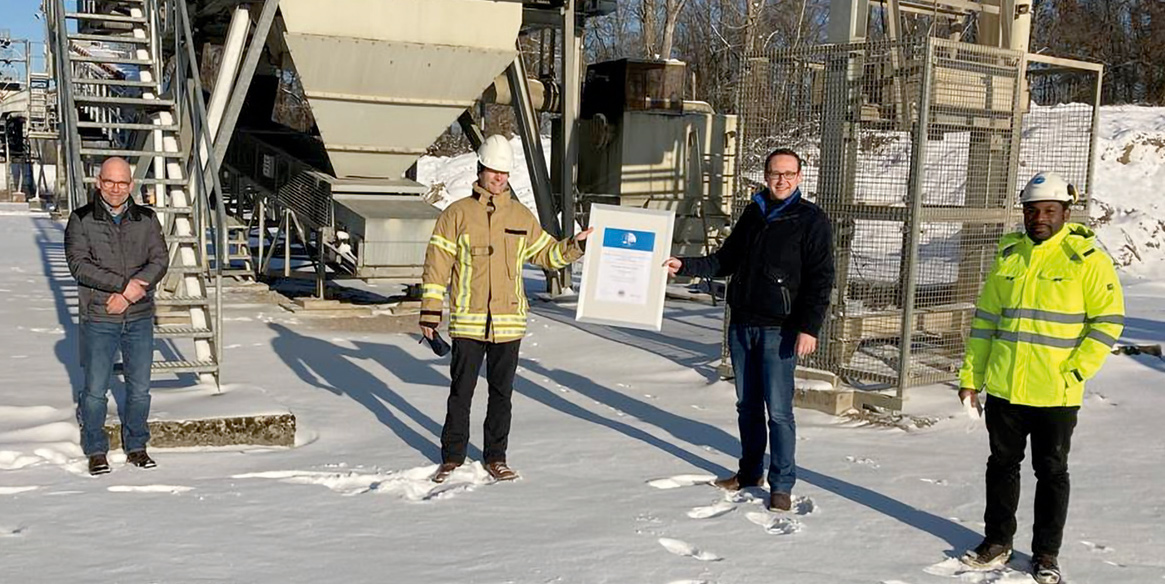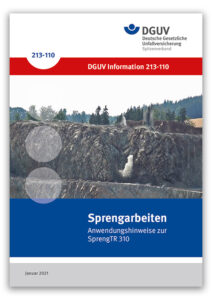In January 2021 the German Social Accident Insurance (DGUV), Berlin/Germany, published an updated version of its information instructions 213-110 on blasting. This had become necessary due to the many changes in blasting rules and regulations in recent years. On 15th June 2021 the DGUV also published figures from the professional indemnity associations and accident insurance bodies for 2020. These showed that the changed working environment during the corona pandemic had reduced occupational accidents to an all-time low. The number of reported occupational diseases, on the other hand, increased significantly.
Seal of approval for Schwenk Beton Nordost: all good things come in fours

Fig. 1. Starting over: Schwenk managing director Uwe Henschen (right) and occupational safety coordinator Lars Bendzmirowski accept the BG RCI Seal of Approval for the fourth time. Photo: Schwenk
In August 2020 various production sites operated by Schwenk Beton Nordost GmbH & Co. KG underwent a repeat assessment for the BG RCI Seal of Approval “Systematic Safety”, this being carried out under the watchful eye of the Association’s Bernd Schneider (Figure 1). Because of pandemic restrictions this audit was rescheduled from April to August 2020. The company was first awarded the Seal of Approval in 2010 and has successfully defended it three times since then.
The outcome of the rescheduled assessment confirms that Schwenk Beton Nordost continues to fulfil its basic legal and organisational requirements for the systematic integration of occupational safety and health protection into the company structure at all production sites with a total workforce of 49 employees. However, as the firm’s occupational safety coordinator, Lars Bendzmirowski, is quick to point out: “No one at the company will be resting on their laurels”. Since November 2020 Schwenk and its employees now have it in writing that their work safety practices are properly organised on systematic lines.
Author: Lars Bendzmirowski, Schwenk Beton Nordost GmbH & Co. KG, Rostock/Germany
Seal of Approval for Edelsplitt- und Rheinkieswerk Helmlingen: the effort has been well worth while

Fig. 2. (from left to right) Ingo Rexer, Martin Rauscher (BG RCI assessor), Jan Kunze, Marc Feutzeu (BG RCI assignment supervisor). Photo: BG RCI
The Edelsplitt- und Rheinkieswerk Helmlingen GmbH & Co. KG, Rheinau/Germany, has been supplying customers with sand and gravel for more than 75 years – and in 2017 safety was also added to its product portfolio (Figure 2).
Ingo Rexer, Helmlingen’s co-owner and authorised signatory since 2003, has introduced an enhanced programme of safety structures, with the company now participating in the BG RCI alternative care model.
In early 2017 Helmlingen’s technical specialist Jan Kunze was delegated to take on the project “Systematically Safe”. And he made a real success of it: after a mere six months, in July 2017, the chippings and gravel supplier was awarded the BG RCI Seal of Approval for “Systematically Safe”. The company then also went on to acquire re-certification between August and October 2020.
This meant another Seal of Approval for “Systematically Safe”from the BG RCI. And this re-certification process resulted in initiatives that further enhanced safety standards. These measures have already been implemented, leading to a further reduction in risk levels. The company management hopes that the conferment of the Seal of Approval will encourage may other firms – especially small-sized undertakings – to take the assessment road and opt for added safety value.
Motivated by this safety review the company has now introduced organisational improvements, such as the mini risk analysis process – or “5 minute check”. This routine can be used not only for safety purposes but also for the deployment planning of various works.
Author: Martin Rauscher, German Social Accident Insurance Institution for the Raw Materials and Chemical Industry (BG RCI), Heidelberg/Germany
Legal certainty for blasting operations: new DGUV guidelines keep things up-to-date

Fig. 3. An updated version of the DGUV information instructions 213-110 on blasting was brought out in January 2021. Source: DGUV
In January 2021 the German Social Accident Insurance (DGUV), Berlin/Germany, published an updated version of its information instructions 213-110 on blasting (Figure 3). DGUV experts considered that this was needed because of the many changes in blasting rules and regulations in recent years.
The new guidelines are based on the Law on Explosive Substances (SprengG), along with its implementing ordinances. The latter essentially lays down regulations on a wide range of issues such as manufacturing, identification, storage, licensing and certificates of competence and also covers training courses aimed at imparting the necessary expertise. However, occupational safety and health protection are only briefly touched on.
During the 1940s the then Steinbruchs-BG (Liability Insurance Association for the Quarrying Industry) laid down an accident prevention regulation on “blasting” in an effort to mitigate the very high accident rates being recorded at that time. This regulation was regularly updated and remained valid until 2011, when it was replaced by BGR 241 and subsequently by the Technical Regulation on Explosives and Blasting (SprengTR 310 – Blasting work).
DGUV specialists in blasting at the organisation’s department for the raw materials and chemicals industries have now published information instructions 213-110 on “blasting work”. These are aimed at providing the target sector, and especially authorised blasters, with guidance on the application of SprengTR 310.
The information paper covers every aspect of SprengTR 310, with each chapter giving advice designed to support authorised blasting personnel in the application of SprengTR 310.
The DGUV information instructions 213-110 on blasting work can be obtained – free of charge to members – from the BG RCI media shop and can also be ordered in both PDF and printed versions.
Author: Jochen Stürtz, German Social Accident Insurance Institution for the Raw Materials and Chemical Industry (BG RCI), Mainz/Germany
Corona produces all-time low in workplace accidents
The changed working environment during the corona pandemic has reduced the number of workplace accidents to an all-time low (Figure 4). The figures for reported occupational diseases, however, have risen sharply. This was revealed in the data provided by the professional indemnity associations and accident insurance bodies for 2020, which their association, the German Social Accident Insurance (DGUV), Berlin/Germany, published on 15th June 2021.
According to the DGUV statistics the number of notifiable workplace accidents fell from 871,547 in 2019 to 760,492 in 2020, this representing a drop of nearly 13 %. The number of notifiable commute-related accidents was down by about 18 % to 152,823, while the accident insurance figures for students and school-children recorded an even greater decline. While there were some 1,176,664 school-related accidents reported in 2019, this fell to just 691,284 in 2020. This represents a downturn of around 41 %. The number of accidents suffered by pupils on their way to school fell by 34 % to a total figure of 71,764.
There were also fewer fatal accidents at the workplace and on the commute to work. In 2020 399 people died as the result of an occupational accident, 98 fewer than in the year before, while the number of employees who were killed in accidents on their way to or from the workplace fell by almost 23 % to 238. However this large percentage decline in fatal accidents at the workplace can only partly be attributed to the pandemic. In 2019 the number of recorded workplace fatalities stood at an unusually high level. This can be attributed to the fact that owing to delays in concluding criminal proceedings a number of fatal cases from the period 2000 to 2005 were not included in the statistics until 2019.
“Working from home, home-schooling and restricted mobility – the 2020 statutory accident insurance figures reveal a day-to-day picture of the pandemic”, according to Stefan Hussy, Managing Director of the DGUV. “Our task at this difficult time continues to be to support our business establishments and policyholders, e. g., by providing sector-specific assistance that can help make the workplace as safe as possible, even under pandemic conditions. In addition to this we have a responsibility for those insured persons who have contracted an occupational disease or have had a workplace accident linked to COVID-19. We want to provide them with the best possible care and for this reason our medical centres are already offering affected persons an interdisciplinary post-Covid check-up. We have also initiated research aimed at improving the database on “long Covid”.”
The accident insurance agencies have already received a total of 106,491 notifications of a suspected occupational disease, almost 33 % more than in the previous year. Of these, 30,329 were made in connection with an illness related to COVID-19. Staff employed at inpatient or outpatient medical establishments and in laboratories can, under certain conditions, have a COVID-19 related illness recognised as an occupational disease. If illnesses connected with coronavirus are taken out of the reckoning the picture reveals a slight downturn in the remaining occupational diseases.
More than 101,206 suspected cases were settled during 2020 (+ 29 %). The presence of an occupational disease was confirmed in 52,956 of these instances (+ 50 %) and 37,181 of these cases were then officially recognised as such, this representing an increase of more than 100 % compared with the previous year. By the end of 2020 there were 18,065 recognised cases in which COVID-19 had been suspected, with some of these notifications continuing to be processed into 2021. A total of 2,380 people died as a result of an occupational illness in 2020, which was 175 fewer than in 2019.
The costs incurred by the professional indemnity associations by way of medical care, rehabilitation and pensions, e. g., are apportioned to their member companies during the following financial year. This levy was 1.8 % lower in 2020. In this case the contributable income is a major factor for assessing the contribution to be made by each company. Here contributable income means the insurable earnings of dependently employed workers and the insurance amounts of the insured companies. The financial crisis triggered by the pandemic resulted in this contributable income declining by 2 %. Yet despite this downturn the average contribution was held at a stable level and remained at 1.14 % of contributable income. This was in contrast to the slight rise in the apportionment contribution of the public-sector accident insurance agencies.
Author: German Social Accident Insurance (DGUV), Berlin/Germany